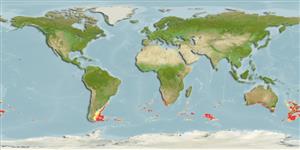>
Aulopiformes (Grinners) >
Notosudidae (Waryfishes)
Etymology: Scopelosaurus: Greek, skopelos = a lantern fish + Greek, sauros = lizard (Ref. 45335).
More on author: Waite.
Environment: milieu / climate zone / depth range / distribution range
Écologie
marin benthopélagique; océanodrome (Ref. 51243); profondeur ? - 1000 m (Ref. 6602). Temperate; 30°S - 61°S
Atlantic, Indian and Pacific: in sub-Antarctic areas. Not known from the Southeast Pacific.
Taille / Poids / Âge
Maturity: Lm ? range ? - ? cm
Max length : 50.0 cm TL mâle / non sexé; (Ref. 6602)
Description synthétique
Morphologie | Morphométrie
Épines dorsales (Total): 0; Rayons mous dorsaux (Total): 10-13; Épines anales 0; Rayons mous anaux: 18 - 21. Dark brownish to blackish in color; paler below with no silvery scales; when specimen is without scales, an indistinct blackish anal spot of the peritoneum showing through the skin may be observed (Ref. 6602).
Larvae and juveniles pseudoceanic in midwater; adults taken by both bottom and pelagic trawls in about 600-800 m. Sub-adults and adults migrate to the Southern Ocean (to 60°S) to feed; on euphausiids, hyperiids, and other crustaceans as well as on small fishes, like myctophids; juveniles take small zooplankton, especially copepods.
Life cycle and mating behavior
Maturité | Reproduction | Frai | Œufs | Fécondité | Larves
Krefft, G., 1990. Notosudidae. p. 136-137. In O. Gon and P.C. Heemstra (eds.) Fishes of the Southern Ocean. J.L.B. Smith Institute of Ichthyology, Grahamstown, South Africa. (Ref. 5175)
Statut dans la liste rouge de l'IUCN (Ref. 130435)
Menace pour l'homme
Harmless
Utilisations par l'homme
Pêcheries: sans intérêt
Plus d'informations
Noms communsSynonymesMétabolismePrédateursÉcotoxicologieReproductionMaturitéFraiRassemblement de ponteFéconditéŒufsDéveloppement de l'œuf
Taille/ÂgeCroissanceLongueur-poidsLongueur-longueurFréquences de longueursMorphométrieMorphologieLarvesDynamique des populations larvairesRecrutementAbondanceBRUVS
RéférencesAquacultureProfil d'aquacultureSouchesGénétiqueElectrophoresesHéritabilitéPathologiesTraitementNutrientsMass conversion
CollaborateursImagesStamps, Coins Misc.SonsCiguateraVitesseType de nageSurface branchialeOtolithesCerveauxVision
Outils
Articles particuliers
Télécharger en XML
Sources Internet
Estimates based on models
Preferred temperature (Ref.
123201): 1.6 - 12.6, mean 7.1 °C (based on 276 cells).
Phylogenetic diversity index (Ref.
82804): PD
50 = 0.5001 [Uniqueness, from 0.5 = low to 2.0 = high].
Bayesian length-weight: a=0.00288 (0.00120 - 0.00692), b=3.18 (2.96 - 3.40), in cm total length, based on LWR estimates for this (Sub)family-body shape (Ref.
93245).
Niveau trophique (Ref.
69278): 3.4 ±0.40 se; based on food items.
Fishing Vulnerability (Ref.
59153): Moderate vulnerability (40 of 100).
